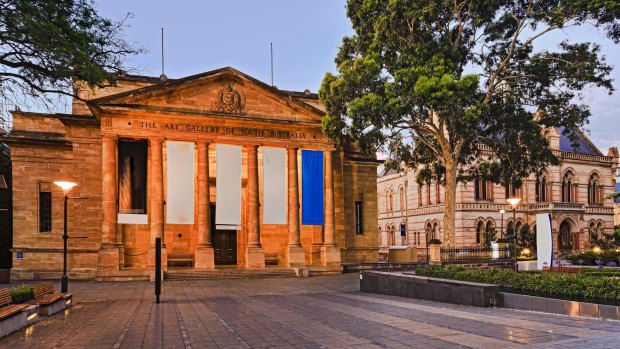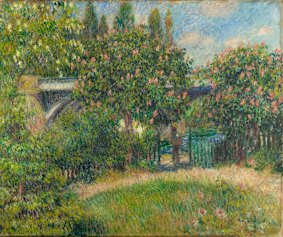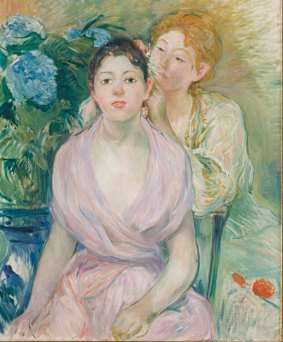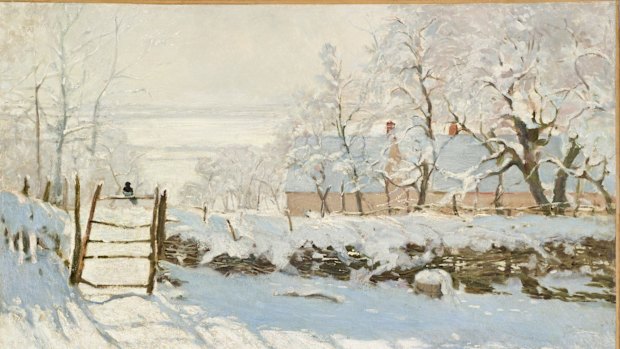This was published 6 years ago
French Impressionism masterpieces from Paris on exhibition at The Art Gallery of South Australia
By Steve Meacham

The Art Gallery of South Australia.Credit: Alamy
Paul Perrin is guiding me through Colours of Impressionism – the most complete collection of French Impressionist paintings ever seen on Australian soil and the biggest art coup in Adelaide's history.
Two days before the official opening at the Art Gallery of South Australia (AGSA), specialist staff are still putting finishing touches to "the hanging" of 65 masterpieces, but the quality of the artists is plain to see: Monet, Renoir, Pissarro, Cezanne, Gauguin and Seurat, among others.
We could be on the banks of the Seine, but instead we're closer to the River Torrens – that tranquil flow meandering through the capital of South Australia, pretending to be a torrent.

'Pont du chemin de fer a Chatou' by Auguste Renoir.Credit: Patrice Schmidt
Perrin is curator of painting at France's Musée d'Orsay (which is to French Impressionism what the Louvre is to the rest of world culture). With his colleague Marine Kisiel, he put together this unprecedented exhibition.
Never before has the Musée d'Orsay mounted a travelling exhibition devoted exclusively to a history of the Impressionist movement through the artist's use of colour and light, Perrin insists: "You won't see one of our Van Goghs, or a Symbolist painting."
These six rooms explain who the Impressionists were, how their use of colour was influenced by older artists, such as Delacrois, and how they each brought their own, unique artistry and thinking to the canvas.

'L'hortensia' (The hydrangea) by Berthe Morisot 1894, oil on canvas.Credit: Patrice Schmidt
Clearly, the exhibition is a tourism gamble. It's been backed by the Turnbull Federal government, the (recently deposed) Weatherill Labor SA government and the taxpayer-funded Art Exhibitions Australia – an investment designed to reinforce Adelaide's reputation as a cultural destination.
No-one will comment officially on how many tourists – mainly from Victoria, NSW, Queensland and New Zealand – are likely to be tempted to invest in a short break or an extension to an existing trip to see this show. Nor has Traveller been able to obtain comment about much the exhibition – which includes three paintings from the AGSA's own collection (including a Pissaro acquired in 2013, which was the catalyst of this exhibition) – has cost to host.
Expectations, however, are high. The exhibition is mentioned in the same breath as the 2018 Adelaide Festival which has broken all records, taking more than $4 million at the box office.About a third of those visitors travelled interstate or from overseas, according to official figures. How much is that worth to the SA economy? Upwards of $28 million if it matches the Adelaide Festival, according to official 2016 figures.

'La Pie' by Claude Monet. Tra30-ImpressionistsCredit: Patrice Schmidt
To put that in perspective, Sydney's Art Gallery of NSW recently won $244 million in funding for its controversial "Global museum of the future" extension. The NSW government's rationale in ticking off that kind of investment? Australia's oldest city is losing out to Melbourne and Brisbane when it comes to hosting major international art exhibitions.
But back to Perrin. He's walking me through the themed rooms to show me his favourite painting in the show: a Renoir. I had assumed it would be one of the artist's famous portraits of women, often dismissed as "chocolate box art" because of their seductive charm. Perrin's pick, however, is surprising: it's The Railway Bridge at Chatou, a landscape painted in 1881, by which time Renoir and the other French Impressionists were already celebrities. Except for the painting's title, you might not even spot the intrusion of the railway – and all it would mean for world transformation – amid all the orchard colours.
Why does Perrin rate it so highly? "It was painted in the open air when he was at the height of his mastery of Impressionism. Soon he would turn to something more classical.
"It is a very simple scene, of a garden on an island in the Seine. Then in the background you notice the railway bridge, the first railway opened in France."
To us, the scene might seem quaint or picturesque. "But, absolutely, it was not," says Perrin. "The Impressionists were the first artists to give prominence to such modern motifs.
"This is how the French landscape was at the time. It is changing, moving. But there is no antagonism in this Renoir painting. The railway bridge looks as if it could have been there for 100 years. The world he creates is one of harmony between nature and progress."
This is the first time in decades that the AGSA's Victorian-era Elder Wing – designed in the 1880s – has been entirely dedicated to a ticketed exhibition of visiting works. – It is one of the nation's few purpose-built 19th Century gallery spaces and usually houses the gallery's main attraction, its collection of Australian art.
"This is unprecedented, and may never happen again," says AGSA's director, Nick Mitzevich.
Moving Australian art out of the Elder Wing, he says, was "driven by the motivation to show 19th Century paintings in an original 19th building … to enhance the appreciation and understanding of the period in which the works were painted."
Though the Musee d'Orsay is a converted railway station, its galleries are very modern. "We don't have the height or the light of the Elder Wing in Paris," Perrin says. "When the painters were creating their pictures, they wanted them to be hung in spaces like these."
Impressionists of this calibre are now held in such high esteem, it's easy to forget they were shunned and ridiculed by the conservative Parisian art elite of their day. The "Impressionist" label was originally a pejorative term coined by a critic who complained their paintings were mere unrefined impressions compared to the work chosen by the ultra-conservative Academie des Beaux-Artes for its annual Salon exhibition.
Things came to a head in 1863 when the Academy rejected a huge number of works, including Edouard Manet's masterpiece, Le dejeuner sur l'herbe.
The first Salon des Refuses emerged from the mass rejection and it proved more popular than the official Salon.
Though Manet did not consider himself an Impressionist, he is acknowledged as the movement's "older brother", and Mitzevich selects a Manet as his favourite work in the new show. "I'm absolutely drawn to Moonlight over the Port of Boulogne," he says. "The loose brushstrokes and the dark colours conjure a sense of drama. Its positioning in the beginning of the exhibition also prefigures the revolution in colour that was to come."
The Impressionists were working in an era of huge technological change. Chemists had invented new pigments that had never been available to artists before, packaged in convenient tubes and available at affordable prices.
This freed them from the studio and allowed them to paint en plein air (working in the open air, at their outdoor easels – something we take for granted now).
There are 10 works by Monet in the Adelaide exhibition – a generous loan by any museum, let alone one as important to France's tourist economy as the Musée d'Orsay.
The most famous painting in the exhibition is a Monet: La Pie. It is the artist's largest winter landscape and was painted in 1869, during a personal crisis. Monet's muse, model (and later wife) had just given birth to their first son, but his family had forbidden him from seeing her.
In the bleak mid-winter, Monet's patron arranged for the painter's new family to stay in secret in Normandy cottage.
Monet's version of a small, solitary magpie stranded on a fence gate in a snowy-white landscape can be seen as a study in monochrome or perhaps a comment on his own sense of isolation. Study it more closely, however, and rich details and colour emerge: blue shadows reflected on the snow, subtle colours of the hedgerows and the infinite horizon, perhaps symbolising struggle and hope.
Colours of Impressionism: Masterpieces from the Musee d'Orsay ends on July 29.
Steve Meacham was a guest of the South Australian Tourist Commission.
TRIP NOTES
MORE
traveller.com.au/south-australia
South Australian Tourism, see southaustralia.com
Art Gallery of South Australia, see artgallery.sa.gov.au.
FLY
Adelaide is served by Qantas, Virgin Australia and several international airlines.
See qantas.com
STAY
The Mayfair Hotel: a five-star hotel re-invented from the former Colonial Mutual Building.
Sign up for the Traveller Deals newsletter
Get exclusive travel deals delivered straight to your inbox. Sign up now.